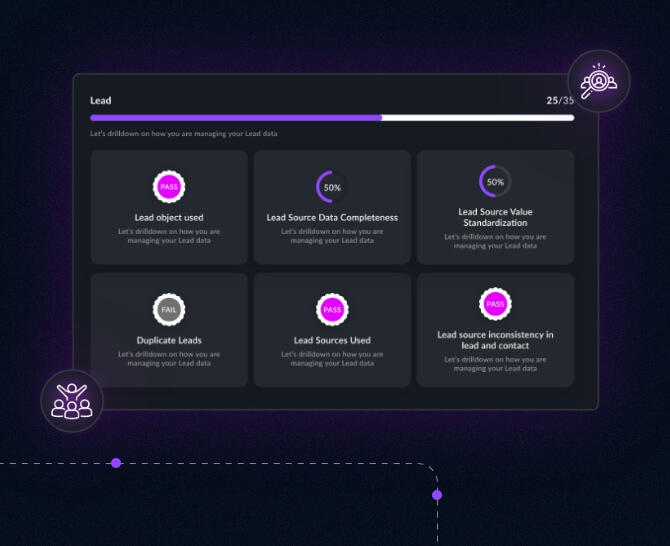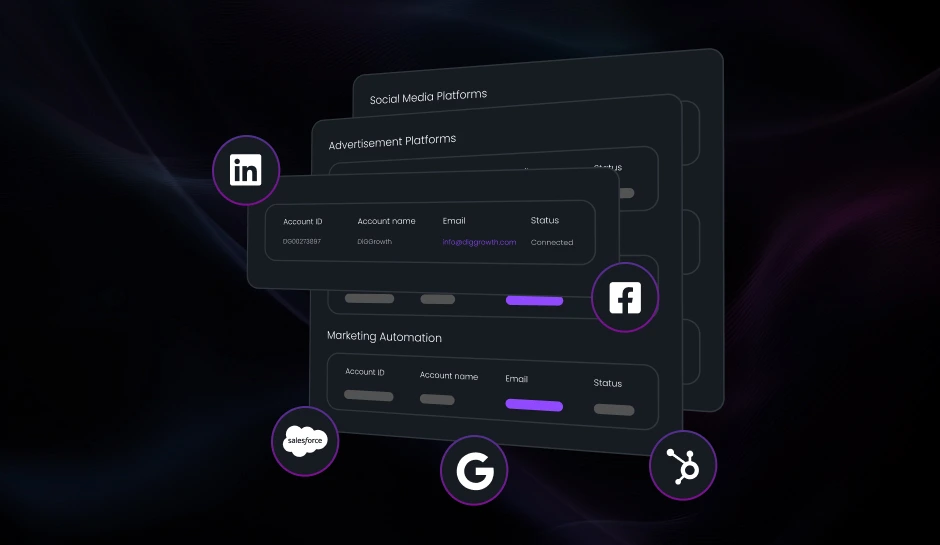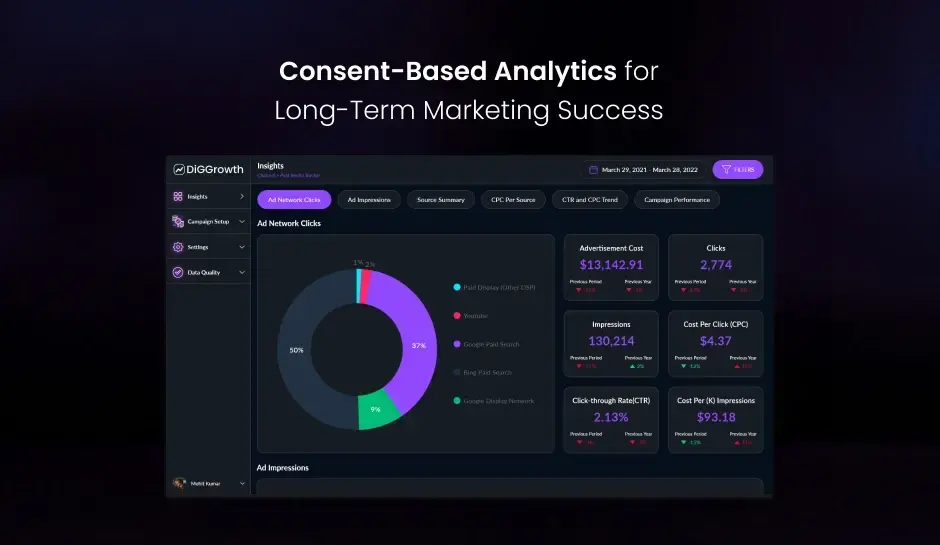
What is Lead to Account Matching and Why Should You Care About It?
Lead to account matching lets you verify which leads belong to which accounts and track their interactions and engagement over time. In this article, we dive into what lead to account matching is and why it matters for your business.
Did you know, only 7% of sales reps believe they receive high-quality leads from the marketing team? HubSpot published this startling stat in a study titled, “The State of Marketing 2023.”
According to estimates, more than 60% of B2B companies struggle with lead quality. This results in wasted time and resources for the sales reps. As marketing teams double up on generating fresh leads (their primary mandate), the quality of the leads can take backstage.
As competition heats up and B2B businesses jostle for space among the same finite client base, improving the efficiency of the process and the quality of leads is essential. One solution to this problem is lead to account matching, which lets you connect leads with their corresponding accounts in your CRM system. Let us dive deeper into lead to account matching and see why it matters for your B2B business.
What is Lead to Account Matching?
Lead to account matching involves matching leads to their corresponding accounts within your CRM system. It allows you to verify which leads belong to which accounts and to track their interactions and engagement over time. Lead to account matching redirects the lead to the concerned sales reps (account) instead of chaos between your inbound and outbound teams.
This concept isn’t new and B2B businesses in the past have tried manual lead to account marketing matching. However, manual matching is inherently inefficient and can become inaccurate and error-prone as you scale up your business. Hence, it is important to automate lead-to-account matching and make the process efficient and rewarding.
For example, if Tom from ABC Inc. downloads your product brochure, lead-to-account matching would automatically associate that Tom is interested in the product and map Tom and everyone else from ABC Inc. with an account that handles this product.
Why Is Lead to Account Matching Important?
Lead to account matching is important for B2B companies because it allows you to avoid duplicate records, reduce data entry errors, and improve lead quality. Without lead to account matching, you may have two different people or teams reaching out to the same lead leading to confusion, wrong sales projections, and irritation on the part of the lead. By matching leads to their corresponding accounts, you can get a complete view of engagement with the account and tailor sales and marketing efforts for increased revenue and customer satisfaction.
Benefits of Lead to Account Matching
Embracing lead to account matching has several benefits for your business. Let us take a look at them.
- Improved Data Accuracy:
- Better Lead Qualification:
- Better Sales and Marketing Alignment:
- Enhanced Account-Based Marketing:
- Improved Customer Experience:
By matching leads to their corresponding accounts, you can avoid duplicate records and reduce data entry errors, resulting in more accurate and reliable data. Multiple people in your team won’t chase the same lead again.
When you embrace this process, you can identify which leads belong to which accounts and track their engagement throughout the lifecycle of the business. You can qualify leads easily and focus your sales and marketing efforts on the accounts most likely to convert.
Every business needs to improve sales and marketing alignment in today’s environment. Lead to account matching improves collaboration between your sales and marketing teams and gives both teams a complete overview of the account’s engagement with your company. You can tailor your messaging and outreach to each account’s specific needs and interests by doing so.
It fosters an environment for account-based marketing, targeting high-value accounts with personalized marketing campaigns. By matching leads to their corresponding accounts, you can identify which accounts are most important to your business and tailor your marketing efforts for higher engagement.
Finally, it lets you offer a personalized and seamless customer experience by ensuring that each lead is associated with the correct account. You will build trust and credibility with your customers, which can lead to increased customer loyalty and retention.
What Should You Look for in a Lead to Account Matching Software?
When choosing a lead to account matching software, you will be overwhelmed as several tools are available. Here are some of the important things you should keep in mind:
- Ease-of-Use:
- Data Accuracy:
- Free Trial:
- Scalability:
- Flexibility:
- Reporting and Analytics:
You don’t want to force your team through a steep learning curve, do you? Look for a user-friendly and easy-to-use tool, even for non-technical users. The software should have a simple interface and intuitive workflows.
Integration with Existing Systems: The software should integrate seamlessly with your existing CRM and marketing automation systems. The lack of this feature can create new complexities for your team and lead to data silos and inconsistency.
The software you choose must match leads to accounts with a high degree of accuracy, even in cases where there is incomplete or inconsistent data. Look for a tool that uses advanced algorithms and machine learning to improve data accuracy.
Better to be safe than sorry. Don’t end up spending money on a tool you aren’t comfortable using. See if the tool offers a free trial to judge its pros and cons.
Your business will grow, and the software should be able to handle large volumes of leads and accounts without compromising on performance or accuracy. Look for a tool that can scale your business as your needs evolve.
The tool should let you customize your lead to account matching rules and workflows and address the unique challenges that you face. You must be able to tailor it as your business needs change.
It should provide comprehensive reporting and analytics capabilities, letting you track the performance of your process. A tool that provides real-time insights and dashboards is a winner.
How Lead to Account Matching Works
Lead to account matching is a crucial process in any business’ sales and marketing strategy. It allows companies to connect the dots between leads and their corresponding accounts, enabling more effective targeting and personalized outreach. Here is an overview of how lead to account matching works:
A. Overview of the process
The lead to account matching process typically starts with data analysis and cleansing. This involves reviewing and organizing the available customer and prospect data to ensure accuracy and consistency. Once the data is in order, the actual matching process begins.
To match leads to accounts, various data points are utlized, such as contact information, firmographics, account hierarchies, and more. Using sophisticated algorithms and rules, the system compares these data points to identify potential matches.
Often, multiple matching criteria are employed to increase the accuracy of the matches. These criteria can include company names, addresses, phone numbers, and even IP addresses. The goal is to find the best possible matches and eliminate false positives.
B. Usage of data management tools
Data management tools play a crucial role in lead to account matching. These tools are designed to centralize and standardize customer data, making it easier and more efficient to identify connections between leads and accounts.
With the help of data management tools, businesses can automate the matching process and ensure that new leads are promptly linked to the appropriate accounts. These tools also enable ongoing data enrichment, enhancing the accuracy and completeness of the matching results over time.
C. Utilizing Customer Relationship Management (CRM) systems
Customer Relationship Management (CRM) systems are another key component in the lead to account matching process. These systems act as a central repository for customer and prospect information, offering a comprehensive view of each account and its associated leads.
By integrating lead to account matching capabilities into CRM systems, businesses can streamline the process and ensure that sales and marketing teams have access to accurate and up-to-date data. This integration enables better lead routing, personalized messaging, and more targeted campaigns, ultimately driving higher conversion rates and revenue.
Implementing Lead to Account Matching
A. Steps for successful implementation
Implementing lead to account matching is crucial for maximizing the effectiveness of your sales and marketing efforts. Follow these steps to ensure a successful implementation:
Identifying and gathering relevant customer data: Start by identifying the key data points that are necessary for accurate lead to account matching. Gather information such as company name, industry, job title, and any other relevant data that can help in identifying the right accounts.
Cleaning and enriching the data: After gathering the relevant customer data, it’s important to clean and enrich the data to ensure accuracy. Remove any duplicates, incorrect or outdated information, and validate the data to ensure its quality.
Utilizing Salesforce for lead to account matching: Salesforce provides powerful tools for lead to account matching. Utilize its features and functionalities to match leads to their respective accounts accurately. Configure the matching criteria and algorithms based on your specific business requirements.
B. Best practices for implementation
To make the most out of lead to account matching, keep the following best practices in mind:
Ensuring data accuracy and consistency: Accuracy and consistency of data are critical for successful lead to account matching. Regularly review and update your customer data to maintain its quality. Implement data quality processes and invest in data cleansing tools to minimize errors.
Regular data updates and maintenance: Customer data can change frequently. It’s essential to regularly update and maintain your data to ensure accurate lead to account matching. Develop a system for ongoing data updates and establish data governance practices.
Lead to Account Matching and Customer Profiling
Lead to account matching is a crucial process in customer profiling for businesses. By leveraging lead to account matching, companies can gain valuable insights into their customers and personalize their marketing efforts accordingly.
A. Leveraging lead to account matching for customer profiling
Customer profiling involves creating detailed profiles of potential customers based on various demographic, firmographic, and psychographic data points. Lead to account matching plays a significant role in this process by identifying the relationships between leads and accounts.
With the help of lead to account matching, businesses can accurately determine which leads belong to which accounts. This information enables them to analyze the characteristics and behavior of their customers, identify common patterns, and build comprehensive customer profiles.
By understanding the specific attributes and preferences of their target customers through lead to account matching, businesses can create targeted marketing campaigns and deliver personalized experiences that resonate with their audience.
B. Personalizing customer experiences based on matched data
Lead to account matching provides businesses with the data they need to personalize customer experiences effectively. By matching lead data with account information, companies can gain insights into the specific needs, pain points, and preferences of individual customers.
With this information, businesses can craft personalized marketing messages, tailor their product offerings, and customize their communications to cater to the unique interests and preferences of each customer. This level of personalization can significantly enhance customer satisfaction, engagement, and loyalty.
Furthermore, by leveraging lead to account matching for customer profiling, businesses can segment their customer base effectively. By dividing customers into distinct groups based on their shared characteristics, businesses can create targeted marketing campaigns that speak directly to each segment’s needs, resulting in higher conversions and improved return on investment.
To ensure that your marketing and sales teams succeed, it’s essential to equip them with the right tools. DiGGrowth makes it happen! It ensures that you have the most accurate lead information to match leads to the right accounts so that your teams can bring them home. To see DiGGrowth in action, get a demo, here.
Importance of Lead to Account Matching
Lead to Account Matching plays a critical role in ensuring the success of your sales and marketing efforts. It offers several important benefits that can greatly enhance your overall business performance.
A. Enhancing Sales and Marketing alignment
Lead to Account Matching helps align your sales and marketing teams by accurately identifying which leads belong to specific accounts. This alignment ensures that both teams are on the same page and can work collaboratively towards common goals. It eliminates confusion and improves communication between these two crucial departments, leading to more efficient and effective lead management.
B. Improving Customer Relationship Management (CRM) systems
Lead to Account Matching plays a crucial role in improving the accuracy and reliability of your CRM systems. By accurately associating leads with the correct accounts, you can ensure that your CRM data remains clean and up-to-date. This, in turn, enables your sales and marketing teams to have a comprehensive view of customer interactions, allowing them to make informed decisions and provide personalized experiences to each account.
Benefits of Lead to Account Matching
Lead to account matching offers several key benefits for businesses. By effectively linking leads with their respective accounts, companies can streamline their sales and marketing processes, leading to improved revenue generation and customer relationships.
A. Improved Sales Pipeline Management
Lead to account matching allows businesses to accurately map leads to their corresponding accounts, providing a holistic view of the sales pipeline. This enables sales teams to better prioritize their activities, focusing on the most valuable accounts and opportunities. By aligning leads to accounts, businesses can effectively track and manage the progression of leads through the sales funnel, optimizing conversion rates and driving higher sales revenue.
B. Enhanced Customer Segmentation
Lead to account matching enables businesses to segment their customer base accurately. By associating leads with specific accounts, companies can gain insights into their customers’ profiles and preferences. This information can be leveraged to tailor marketing campaigns, personalize communications, and deliver targeted offers to different customer segments. Enhanced customer segmentation improves engagement and conversion rates, boosting customer satisfaction and loyalty.
Tracking and Analyzing Lead to Account Matching Results
Tracking and analyzing the results of your lead to account matching efforts is crucial for optimizing your sales and marketing strategies. By closely monitoring and measuring the effectiveness of your lead to account matching processes, you can identify areas of improvement and make data-driven decisions to enhance your overall lead generation and management efforts.
A. Importance of sales and marketing analytics
Implementing sales and marketing analytics is essential for gaining valuable insights into the performance of your lead to account matching strategies. By capturing and analyzing relevant data, you can measure the success of your lead to account matching efforts and identify any discrepancies or gaps. Sales and marketing analytics can provide valuable metrics such as conversion rates, lead quality, and ROI, enabling you to make informed decisions and optimize your lead generation and account-based marketing strategies.
B. Key performance indicators for measuring lead to account matching success
- Conversion rate
- Lead quality
- Revenue impact
- Account engagement
Tracking the percentage of leads that successfully convert into closed accounts is crucial for assessing the effectiveness of your lead to account matching efforts. A high conversion rate indicates that your matching processes are successfully identifying and targeting the right accounts.
Analyzing the quality of leads that are matched to specific accounts can help you gauge the accuracy of your matching algorithms. By tracking metrics such as lead-to-opportunity conversion rates and customer lifetime value, you can ensure that your lead to account matching efforts are generating high-quality leads that are more likely to convert into valuable customers.
Measuring the revenue impact of your lead to account matching strategies is essential for evaluating their overall effectiveness. By tracking the revenue generated from matched accounts, you can determine the direct impact of your matching processes on your bottom line.
Monitoring the level of engagement and interaction from matched accounts can help you assess the effectiveness of your lead to account matching efforts. By tracking metrics such as email open rates, click-through rates, and overall account activity, you can identify the accounts that are most responsive to your marketing efforts and focus your resources accordingly.
By regularly tracking and analyzing these key performance indicators, you can gain valuable insights into the effectiveness of your lead to account matching strategies. These insights can help you make data-driven decisions, optimize your lead generation and account-based marketing efforts, and ultimately drive greater revenue and success for your business.
The Bottom Line
Lead to account matching is a critical component of successful account-based marketing (ABM) strategies. By accurately linking leads to their respective accounts, businesses are able to align their marketing and sales efforts, resulting in greater efficiency and effectiveness.
Throughout this content, we have explored the importance of lead to account matching and how it works. We have also discussed the benefits it brings to organizations, such as improved personalization, better lead management, and increased sales conversions.
To successfully implement lead to account matching, businesses should consider the following actionable steps:
Step 1: Evaluate existing data quality and consider data cleansing and enrichment for better matching accuracy.
Step 2: Identify and address challenges associated with lead to account matching, such as duplicate records or mismatched data.
Step 3: Leverage lead to account matching for email prospecting by tailoring messages specifically to the identified accounts.
Step 4: Integrate lead to account matching into the sales process to facilitate effective targeting and coordination between marketing and sales teams.
Step 5: Manage contacts and leads through lead to account matching to ensure accurate tracking and appropriate follow-up.
By following these steps, businesses can maximize the benefits of lead to account matching and enhance their overall ABM efforts.
In conclusion, lead to account matching is a crucial element in modern marketing strategies. It enables organizations to better understand their leads, target them effectively, and drive meaningful business outcomes. By implementing lead to account matching and continuously tracking and analyzing its results, businesses can stay ahead of the competition and achieve greater success in their marketing and sales endeavors.
Lead to account matching is a powerful tool that can help B2B companies improve their sales and marketing effectiveness. By matching leads to their corresponding accounts, you can gain a complete view of the engagement with the account and make more informed decisions.
Want to Get Lead to Account Matching Just Right? Let’s Talk!
If you are looking for a tool that arms your team with the power of data-driven decision-making and is easy to use, DiGGrowth should be on your radar. Write to us at info@diggrowth.com and we’ll get back to you.
Ready to get started?
Increase your marketing ROI by 30% with custom dashboards & reports that present a clear picture of marketing effectiveness
Start Free Trial
Experience Premium Marketing Analytics At Budget-Friendly Pricing.

Learn how you can accurately measure return on marketing investment.
Additional Resources
Integrating Data from Different Channels for a Holistic View of Your Marketing Performance
Who's your ideal customer? Where do they come...
Read full post postGet Your Channels to Play Nice: Integrated Data for Smarter Marketing
If you’re a savvy marketer, you’re living in...
Read full post postConsent-Based Analytics for Long-Term Marketing Success
As marketers, we want our customers to perceive...
Read full post post Subhadeep Bhattacharjee
Subhadeep Bhattacharjee 

